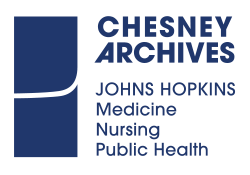The Johns Hopkins Hospital opened on May 7, 1889. It was one of the first models of a teaching hospital, designed to unite functions of patient care with education and research. The founder was Johns Hopkins, a wealthy Quaker merchant and banker in Baltimore. Regarding his wealth as a trust to benefit humankind, he bequeathed his fortune for the establishment of the hospital and university that bear his name. Mr. Hopkins selected the site for the hospital and purchased the tract of land for its construction. Read More >
Records of The Johns Hopkins Hospital
The Records of The Johns Hopkins Hospital document the founding, governance, administration and leadership of the hospital from its inception to today. There are records pertaining to patient care, administrative and clinical departments, unions and employee relations, facilities, and the Johns Hopkins base hospital units during World Wars I and II. There is also a significant group of hospital photographs and official publications, including the Johns Hopkins Hospital Superintendents’ Reports and the Bulletin of the Johns Hopkins Hospital.
- Daniel C. Gilman (1889)
- Henry M. Hurd (1889-1911)
- Winford H. Smith (1911-1946)
- Edwin L. Crosby (1946-1952)
- Russell A. Nelson (1952-1972)
- Steven Muller (1972-1983)
- Robert M. Heyssel (1983-1986 and 1988-1992)
- Albert H. Owens, Jr. (1987-1988)
- James A. Block (1992-1996)
- Ronald R. Peterson (1996-2016)
- Redonda Miller (2016-present)
- Autopsy Records of the Johns Hopkins Hospital
- Medical Records of the Brady Urological Institute
- Admission logbooks
- Surgical logbooks
- Gynecological Pathology records
- Anesthesiology
- Gynecology
- Harriet Lane Home for Invalid Children/Pediatrics
- Medicine
- Neurology and Neurosurgery
- Nursing
- Obstetrics
- Outpatient Center
- Pastoral Care
- Pathology
- Pediatrics
- Phipps Psychiatric Clinic
- Phipps Tuberculosis Dispensary
- Social Work/Social Services
- Surgery
- Urology
- Wilmer Ophthalmological Institute
- Women’s Clinic
- Bulletin of the Johns Hopkins Hospital
- Dome / Under the Dome
- Hopkins Nurse
- The Johns Hopkins Hospital Reports
- Mencken Editorial Series
- Policies and Procedures Manuals
- Postdoctoral Handbooks
- Public Affairs Press Releases
- Report of the Superintendent of the Johns Hopkins Hospital
- Report of the Treasurer of the Hospital
- Scrapbooks
